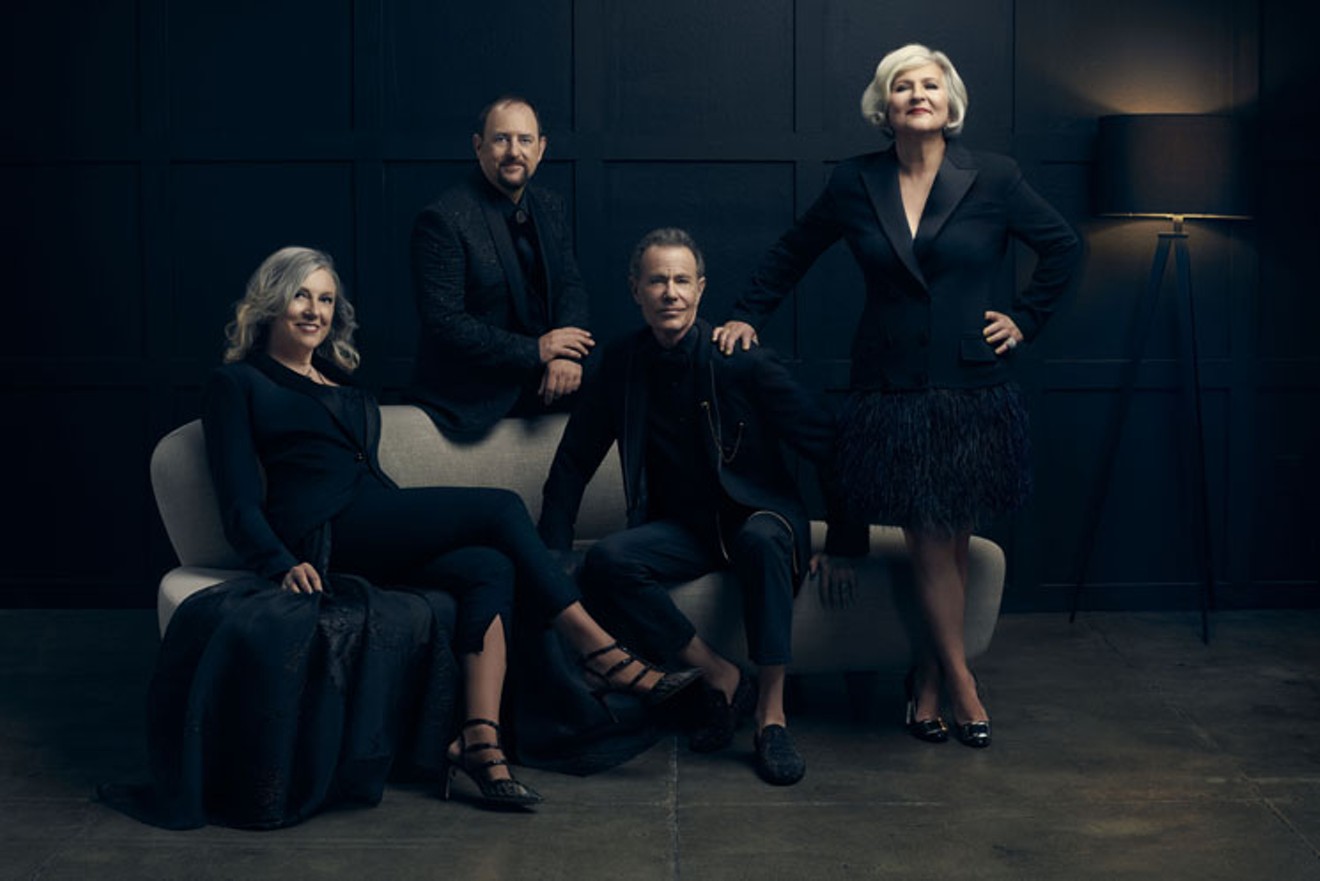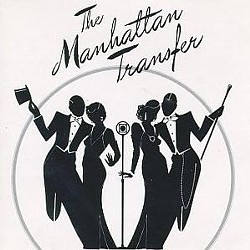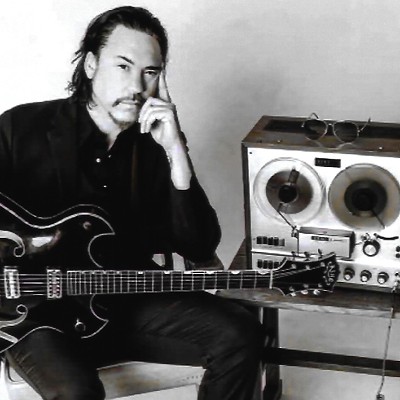A few years before the 1976 movie Taxi Driver came out—complete with its raw depiction of New York City during the era—another “hack” was out on the road trying to figure out his future, this one of a more musical nature.
And in the 1972 world of hard rock, glitter rock, and the beginnings of punk and new wave, said commercial motorist Tim Hauser was really into…four-part vocal harmony. The kind of smooth, sweet and sophisticated sound of blended and perfectly-pitched voices that hadn’t been popular in decades.
His previous group, the Manhattan Transfer (their name taken from a 1925 John Dos Passos novel) had broken up after a few years together and released an album when he and bandmate Gene Pistilli had different musical visions. Hauser was looking to reboot while working odd jobs.
By chance, one of his passengers was Laurel Massé, a tall, brunette singer with similar interests. Another passenger invited him to a party where he met the shorter, spunkier Janis Siegel, already in a vocal harmony group. Massé’s boyfriend was a drummer in the band for the Broadway production of Grease and introduced the trio to Alan Paul, who was possessed of matinee idol looks and a crooner’s croon that served him well onstage as the "Teen Angel."
The four clicked immediately and on October 1, 1972, the new Manhattan Transfer was born.
“This was the thing. It was an amazing time to be in New York City. There was so much freedom in music. And the whole concept was to do this close four-part harmony. That’s what we were focused on,” Paul says today via Zoom, with a Count Basie poster visible in the background (the members’ heart’s desire was for their voices to replicate Basie’s saxophone section: soprano, alto, tenor, and bass).
“We didn’t want to do what everyone else was doing. What’s the point of that?” Paul continues. “We all had this love of close harmony from the groups of the ‘40s and ‘50s and Big Bands like the Pied Pipers, the Modernaires and the Merry Macs. We thought it would be unique. But most people didn’t get it!”
Over the course of five decades, though, millions of fans around the world have “gotten it.” And the band will both celebrate and put a period on at least part of their story with an upcoming worldwide 50th anniversary tour that will double as a farewell trek. On September 23, they’ll also be releasing their Fifty (Craft), for which Paul has written extensive liner notes.
A collaboration with Germany’s WDR Funkhausorchester, it “reimagines” 10 pivotal tracks from the band’s varied career that has found them exploring not only on vocal harmony, but jazz, pop, Big Band, doo-wop, world music, and eve some experimental forays. The lineup today includes original members Paul and Siegel, Cheryl Bentyne (who replaced Massé way back in 1979) and Trist Curless, who joined after Tim Hauser died in 2014.
“It was difficult to announce it. And I’m not even coming to grips with it yet because there’s so much going on,” Paul says of the farewell tour that begins in October and will see the band play nearly 40 dates on and off in the U.S. and Europe before winding up in March of next year.
“The touring gets really hard, especially these days with the pandemic and just being older. It’s not to say we’ll never do anything again, it’s just about touring and especially internationally,” Paul adds.
The genesis for Fifty came from a January 2020 date the band played in Cologne, Germany with WDR Funkhausorchester. It was such a great success and appealing to all involved that plans for a recorded collaboration were begun. Then in March 2020, something, uh, happened.
“That show was so enjoyable, and we thought we should do a project together. Then the pandemic hit and we put it on the shelf for a year. And then we started discussions again,” Paul says.
After working with arrangers and all parties involved mostly via online swapping of ideas, the orchestra laid down their parts in Germany in April 2021, while the Manhattan Transfer did their vocals in the U.S. in various session, as did other musicians.
The result is a seamless recording that doesn’t sound Frankensteined-together. And the ten tracks chosen from their discography include “Agua,” “The Man I Love,” “On a Little Street in Singapore,” “Paradise Within,” “Twilight Zone/Twilight Tone,” “Chanson D’Amour” and end with a cover of the Beach Boys “God Only Knows,” were not chosen by chance.
“The record looks at the major transitions that occurred for us in our career,” Paul says. “We started with a list of 50 songs and narrowed it down to ten. We didn’t just want to do the hits, but the songs that we really loved and that merit new orchestrations. And in some cases, new arrangements.”
For fans, the visual image of the Manhattan Transfer that comes to mind—and more so in the first part of their career—is of vintage elegance, with the gentlemen in tux and tails and the ladies sporting satiny evening dresses and jewelry.
It’s an idea propagated by the band’s distinctive silhouette logo (which actually the second version) that graced the cover of their 1975 debut record and is still in use today. So it’s a little shocking to see that, at the band’s very, very beginnings, their stage wear was far more colorful and outlandish with wigs, bright costumes and bold makeup.
Paul explains that Hauser sister Fayette, who was a member of the San Francisco-based avant garde performing troupe the Cockettes (and made up mostly of transvestites), molded their original look.
“People were just going out in their jeans, and we wanted people to look at us, to grab their attention when we walk on stage before we even opened our mouths. We had nothing to lose. We needed a manager and a record deal,” Paul says of the nearly three years between the scuffling group’s founding and self-titled record debut.
“With the logo, we always felt that we needed one. It was like Coca-Cola, branding. And [Atlantic Records President] Ahmet Ertegun got it. He also understood musically what we were doing.”
Even those who are not familiar with the band’s records have likely heard their biggest commercial success: “The Boy From New York City,” which hit No. 7 on the Billboard singles chart in 1981. It was originally a hit for the Ad-Libs after being released in late 1964 and later, English group The Darts had a UK hit in 1978 with their version.
“We always dug it. There were conversations about it and we were working with [Producer/guitarist] Jay Graydon,” Paul says. “And Janis was great on it. She was that girl from Brooklyn!”
While the farewell tour doesn’t have a Texas date, Paul says he’s aware of the many fans the group has in the state and in Houston. In the late 1990s the Manhattan Transfer had a gig with an orchestra at The Woodlands Pavilion. Paul mentioned from the stage that the intense heat forced the group to call an audible, and they appeared on stage in more comfortable and cool clothing than their prepared formal wear.
“It’s interesting that we do because our music is more New York City urban, then it became California,” he says. “So, it’s touched us that a lot of people in Texas dig us.”
In addition to the tour and the record, Paul is staying pretty busy. He’s writing a memoir, is about two years into working on a documentary about the band, hopes to get back in the studio, and even continue teaching and mentoring young singers.
It is bittersweet, of course, that the man who started the Manhattan Transfer’s journey out of the station isn’t here to celebrate the group’s golden anniversary. When asked what he thinks his old friend Tim Hauser would have made of the band’s story and standing in 2022, Alan Paul pauses a bit, the emotion clear on his face.
“I think he would have absolutely loved to be able to do it, but it just didn’t turn out that way,” Paul sums up. “I think he’s looking down. I think he’s proud. And this is very much his legacy.”
For more on the Manhattan Transfer, Fifty, and the farewell tour, visit ManhattanTransfer.net
Support Us
Houston's independent source of
local news and culture
account
- Welcome,
Insider - Login
- My Account
- My Newsletters
- Contribute
- Contact Us
- Sign out
The Manhattan Transfer Celebrate 50 Years of Vocal Harmony—and the End of Their Touring Days
Bob Ruggiero September 5, 2022 4:00AM

The always-cool Manhattan Transfer today: Cheryl Bentyne, Trist Curless, Alan Paul and Janis Siegel.
Photo by MAD Ink PR
[
{
"name": "Related Stories / Support Us Combo",
"component": "11591218",
"insertPoint": "4",
"requiredCountToDisplay": "4"
},{
"name": "Air - Billboard - Inline Content",
"component": "11591214",
"insertPoint": "2/3",
"requiredCountToDisplay": "7"
},{
"name": "R1 - Beta - Mobile Only",
"component": "12287027",
"insertPoint": "8",
"requiredCountToDisplay": "8"
},{
"name": "Air - MediumRectangle - Inline Content - Mobile Display Size 2",
"component": "11591215",
"insertPoint": "12",
"requiredCountToDisplay": "12"
},{
"name": "Air - MediumRectangle - Inline Content - Mobile Display Size 2",
"component": "11591215",
"insertPoint": "4th",
"startingPoint": "16",
"requiredCountToDisplay": "12"
}
]
KEEP THE HOUSTON PRESS FREE...
Since we started the Houston Press, it has been defined as the free, independent voice of Houston, and we'd like to keep it that way. With local media under siege, it's more important than ever for us to rally support behind funding our local journalism. You can help by participating in our "I Support" program, allowing us to keep offering readers access to our incisive coverage of local news, food and culture with no paywalls.
Bob Ruggiero has been writing about music, books, visual arts and entertainment for the Houston Press since 1997, with an emphasis on classic rock. He used to have an incredible and luxurious mullet in college as well. He is the author of the band biography Slippin’ Out of Darkness: The Story of WAR.
Contact:
Bob Ruggiero
Trending Music
- Country Rock Thrives with Gene Clark and Flying Burrito Brothers for Record Store Day
- Bruce Robison Is The Eternal Song Hunter
- Top 10 Butt-Rock Bands of All Time
-
Sponsored Content From: [%sponsoredBy%]
[%title%]

Don't Miss Out
SIGN UP for the latest
Music
news, free stuff and more!
Become a member to support the independent voice of Houston
and help keep the future of the Houston Press FREE
Use of this website constitutes acceptance of our
terms of use,
our cookies policy, and our
privacy policy
The Houston Press may earn a portion of sales from products & services purchased through links on our site from our
affiliate partners.
©2024
Houston Press, LP. All rights reserved.







